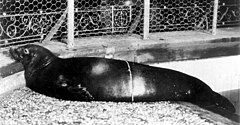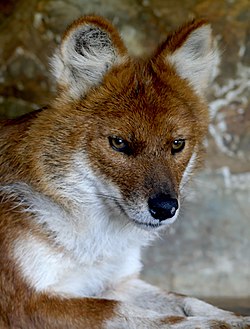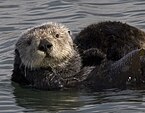From Wikipedia, the free encyclopedia
The quagga became extinct in 1883.
The passenger pigeon became extinct in 1914.
The Mexican grizzly bear became extinct in 1964.
The Caribbean monk seal was officially declared extinct in 2008.
The Holocene extinction, sometimes called the Sixth Extinction, is a name proposed to describe the extinction event of species that has been taking place during the present Holocene epoch (since around 10,000 BCE) mainly due to human activity. The large number of extinctions span numerous families of plants and animals including mammals, birds, amphibians, reptiles and arthropods. Although 875 extinctions occurring between 1500 and 2009 have been documented by the International Union for Conservation of Nature and Natural Resources,[1] the vast majority are undocumented. According to the species-area theory and based on upper-bound estimating, the present rate of extinction may be up to 140,000 species per year.[2]
The Holocene extinction includes the disappearance of large mammals known as megafauna, starting between 9,000 and 13,000 years ago, the end of the last Ice Age. This may have been due to the extinction of the mammoths whose habits had maintained grasslands which became birch forests without them.[3] The new forest and the resulting forest fires may have induced climate change.[3] Such disappearances might be the result of the proliferation of modern humans which led to climate change. These extinctions, occurring near the Pleistocene–Holocene boundary, are sometimes referred to as the Quaternary extinction event. The Holocene extinction continues into the 21st century.
There is no general agreement on whether to consider this as merely part of the Quaternary extinction event, or just a result of human-caused changes.[3][4] Only during these most recent parts of the extinction have plants also suffered large losses. Overall, the Holocene extinction can be characterized by the human impact on the environment.
Prehistoric extinctions
North and South America
There has been a debate as to the extent to which the disappearance of megafauna at the end of the last glacial period can be attributed to human activities, directly, by hunting, or indirectly, by slaughter[clarification needed] of prey populations. Discoveries at Monte Verde in South America and at Meadowcroft Rock Shelter in Pennsylvania have caused a controversy[5] regarding the Clovis Culture. There likely have been human settlements prior to the Clovis Culture, and the history of humans in the Americas may extend back many thousands of years before the Clovis Culture.[5] There is no strong correlation between human arrival and megafauna extinction: for example in Wrangel Island in Siberia the extinction of midget Mammoths (approximately 1000 BCE)[6] did not coincide with the arrival of humans.The ongoing extinction seems more outstanding[clarification needed] in view of the apparent separation[clarification needed] between recent extinctions (approximately since the industrial revolution) and the Pleistocene extinction near the end of the last glacial period. The latter is exemplified by the extinction of large herbivores such as the woolly mammoth and the carnivores that preyed on them. We know that humans of this era actively hunted the mammoth and the mastodon[7] but it is not known if this hunting was the cause of the subsequent massive ecological changes, widespread extinctions and climate changes.[3][4] The ecosystems encountered by the first Americans had not been exposed to human interaction and were far less resilient to human made changes than the ecosystems encountered by industrial era humans, those environments seasoned as they were, having been exposed to over 10,000 years of human interaction. Therefore the actions of the Clovis people and likewise[clarification needed], despite seeming insignificant by today's standards could indeed have had a profound effect on the ecosystems and wild life which was entirely unused to human influence.
- Doedicurus
- American cheetah
- American lion
- Holochilus primigenus
- Pygmy mammoth and woolly mammoth
- Eremotherium
- Smilodon
New Zealand
Circa 1500, several species became extinct after Polynesian settlers arrived, including:- Ten species of moa, giant flightless ratite birds.
- The giant Haast's eagle, Harpagornis
- The flightless predatory adzebills.
Pacific, including Hawaii
Recent research, based on archaeological and paleontological digs on 70 different islands, has shown that numerous species went extinct as people moved across the Pacific, starting 30,000 years ago in the Bismarck Archipelago and Solomon Islands.[8] It is currently estimated that among the bird species of the Pacific some 2000 species have gone extinct since the arrival of humans.[9] Among the extinctions were:- The moa-nalos, grazing ducks from Hawaii.
- The nēnē-nui, or woodwalking goose, from Maui.
- A giant megapode from New Caledonia.
- Mekosuchine crocodiles from New Caledonia, Fiji and Samoa.
- "Gavialis" papuensis from the Solomon Islands.
Madagascar
Starting with the arrival of humans around 2,000 years ago, nearly all of the island's megafauna became extinct, including:- Eight species of elephant birds, giant flightless ratites in the genera Aepyornis and Mullerornis.
- 17 species of lemur, known as giant, subfossil lemurs, including:
- Giant aye-aye (Daubentonia robusta)
- Sloth lemurs, including chimpanzee-sized Palaeopropithecus and gorilla-sized Archaeoindris
- Koala lemurs (Megaladapis), a koala-like, orangutan-sized arboreal lemur
- Monkey lemurs, most terrestrial of lemurs, often compared to baboons or macaques.
- Pachylemur, a genus of giant ruffed lemurs
- Giant fossa
- Plesiorycteropus, a genus containing two species of digging mammal unlike anything alive today
- Two species of Malagasy hippopotamus
Indian Ocean Islands
Starting c. 1500, a number of species became extinct upon human settlement of the islands, including:- several species of giant tortoise on Seychelles and Mascarene Islands all extinct Cylindraspis and Meiolania platyceps
- 14 species of birds on the Mascarene Islands, including the dodo, the Rodrigues solitaire, and the unrelated Réunion solitaire.
Ongoing Holocene extinctions
One scientist estimates the current extinction rate may be 10,000 times the background extinction rate. Nevertheless most scientists predict a much lower extinction rate than this outlying estimate.[10] Stuart Pimm stated "the current rate of species extinction is about 100 times the natural rate" for plants.[11] Mass extinctions are characterized by the loss of at least 75% of species within a geologically short period of time.[12][13][14]Megafaunal extinctions continue into the 21st century. Modern extinctions are more directly attributable to human influences. Extinction rates are minimized in the popular imagination by the survival of captive populations of animals that are extinct in the wild (Père David's deer, etc.), by marginal survivals of highly publicized megafauna that are ecologically extinct (the Giant panda, Sumatran rhinoceros, North American Black-footed ferret, etc.) and by extinctions among arthropods. Some examples of modern extinctions of "charismatic" mammal fauna include:
- Aurochs, Europe
- Tarpan, Europe
- Thylacine or Tasmanian tiger, Thylacinus cynocephalus, Tasmania
- Quagga, a zebra subspecies, Southeast Africa
- Sardinian pika, a primitive lagomorph native to the Mediterranean islands of Sardinia and Corsica
- Steller's sea cow
- Bluebuck
- Pyrenean ibex
- Falkland Islands wolf
- Atlas bear
- Caribbean monk seal
- The closely related Bali tiger and Javan tiger
- Eastern cougar[15]
- Western black rhinoceros
- the dodo, the giant flightless pigeon of Mauritius, Indian Ocean
- the great auk of islands in the north Atlantic
- the passenger pigeon of North America
- several species of moa, giant flightless birds from New Zealand
- the Carolina parakeet of the American southeast
Peter Raven, past president of the American Association for the Advancement of Science (AAAS), states in the foreword to their publication AAAS Atlas of Population and Environment:[16] "We have driven the rate of biological extinction, the permanent loss of species, up several hundred times beyond its historical levels, and are threatened with the loss of a majority of all species by the end of the 21st century."[17]

The Golden toad of Costa Rica, extinct since around 1989. Its disappearance has been attributed to a confluence of several factors, including El Niño warming, fungus, and the introduction of invasive species.
189 countries which are signatory to the Convention on Biological Diversity (Rio Accord) have committed to preparing a Biodiversity Action Plan, a first step at identifying specific endangered species and habitats, country by country.
Various species are predicted to go extinct in the near future.[18][19][20][21]
Human influence on extinction
Extinction of animals, plants, and other organisms caused by human actions may go as far back as the late Pleistocene, over 12,000 years ago. There is evidence that abrupt climate change has especially played an enormous role in the extinction of larger mammals.[22] However, while previous mass extinctions were due to natural environmental causes, research shows that wherever on Earth humans have migrated, other species have gone extinct, and human population growth, most prominently in the past two centuries, is regarded as one of the underlying causes of this Holocene extinction event.[23] In terms of how humans have contributed to this mass extinction, three major factors include: the increased global concentration of greenhouse gases, affecting the global climate; oceanic devastation, such as through overfishing and contamination; and the modification and destruction of vast tracts of land and river systems around the world to meet solely human-centered ends (with 10 to 15 percent of Earth's land surface now used as urban-industrial or row-crop agricultural sites and 6 to 8 percent used as pastures), thus ruining the local ecosystems.[24][25] Other, related human causes of the extinction event include deforestation, hunting, pollution,[26] the introduction in various regions of non-native species, and the widepsread transmission of infectious diseases. At present, the rate of extinction of species is estimated at 100 to 1,000 times higher than the "base" or historically typical rate of extinction (in terms of the natural evolution of the planet)[27] and also the current rate of extinction is, therefore, 10 to 100 times higher than any of the previous mass extinctions in the history of Earth.[citation needed] On the other hand, this extinction concerns a large number of plants, different from previous extinctions.The abundance of species extinctions considered anthropogenic, or due to human activity, have sometimes (especially when referring to hypothesized future events) been collectively called the "Anthropocene extinction".[28][29] The Anthropocene is a term introduced in 2000. Most biologists believe that we are at the beginning of an anthropogenic mass extinction that is accelerating at a large rate.[citation needed] In The Future of Life (2002), E.O. Wilson of Harvard calculated that, if the current rate of human disruption of the biosphere continues, one-half of Earth's higher lifeforms will be extinct by 2100. A 1998 poll conducted by the American Museum of Natural History found that seventy percent of biologists believe that we are in the midst of an anthropogenic extinction.[30] Numerous scientific studies—such as a 2004 report published in Nature,[31] and papers authored by the 10,000 scientists who contribute to the IUCN's annual Red List of threatened species—have since reinforced this conviction.
The evidence of all previous extinctions is geological in nature, and shorter geological time scale is of the order of several hundred thousand to several million years. Even extinctions caused by instantaneous events such as the impact of the asteroid in Chicxulub, which is currently the best example, extend the equivalent of many human lives, due to complex ecological interactions that are triggered by the event.[citation needed]
Recent extinctions described are well-documented,[22] but the nomenclature used varies. The term Anthropocene is a term that is used by few scientists,[22] and some commentators may refer to the current and projected future extinctions as part of a longer Holocene extinction.[32] The Holocene–Anthropocene boundary is contested, with some commentators asserting significant human influence on climate for much of what is normally regarded as the Holocene Epoch.[33] Other commentators place the Holocene–Anthropocene boundary at the industrial revolution while also saying that "Formal adoption of this term in the near future will largely depend on its utility, particularly to earth scientists working on late Holocene successions."[22]
Three hypotheses have been proposed to explain the extinction of megafauna in the late Pleistocene. Of these, only two have much scientific credibility. Although Ross McPhee proposed that a hyper-disease may have been the cause of the extinction,[34] the study by Lyons et al., demonstrated conclusively that a hyperdisease was unlikely to have caused the extinction.[35] The two main theories to the extinction are climate change and human hunting. The climate change theory has suggested that a change in climate near the end of the late Pleistocene stressed the megafauna to the point of extinction.[36] Some scientists favor abrupt climate change as the catalyst for the extinction of the mega-fauna at the end of the Pleistocene, but there are many who believe increased hunting from early modern humans also played a part.[37][38]
De-extinction
De-extinction is the process of creating an organism, which is a member of or resembles an extinct species, or a breeding population of such organisms. Cloning is the most widely proposed method, although selective breeding has also been proposed.Several species that have gone extinct during the holocene period have been proposed for de-extinction. These include: passenger pigeon, moa, heath hen, dodo and woolly mammoth.
















